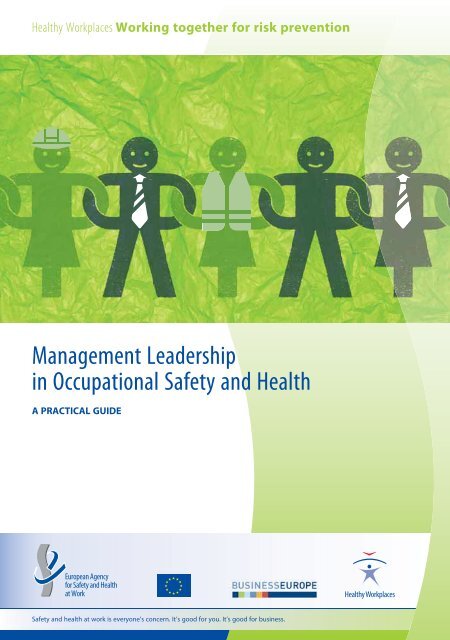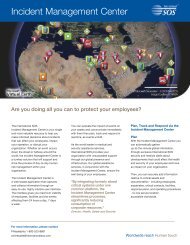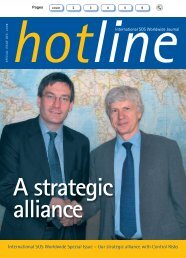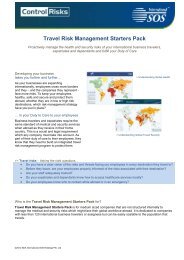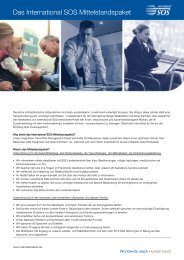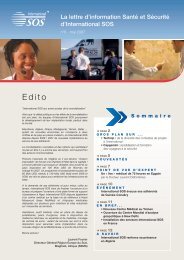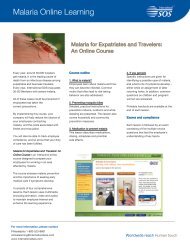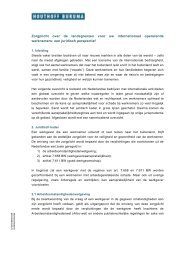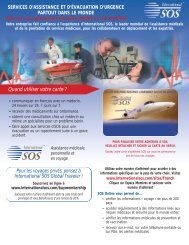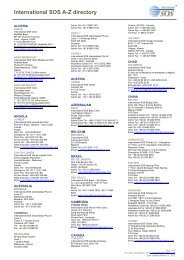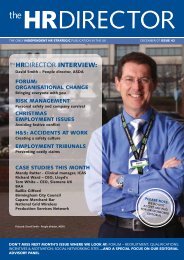Management Leadership in Occupational Safety and Health
Management Leadership in Occupational Safety and Health
Management Leadership in Occupational Safety and Health
Create successful ePaper yourself
Turn your PDF publications into a flip-book with our unique Google optimized e-Paper software.
<strong>Health</strong>y Workplaces Work<strong>in</strong>g together for risk prevention<br />
<strong>Management</strong> <strong>Leadership</strong><br />
<strong>in</strong> <strong>Occupational</strong> <strong>Safety</strong> <strong>and</strong> <strong>Health</strong><br />
A PRACTICAL GUIDE<br />
European Agency<br />
for <strong>Safety</strong> <strong>and</strong> <strong>Health</strong><br />
at Work<br />
<strong>Health</strong>y Workplaces<br />
<strong>Safety</strong> <strong>and</strong> health at work is everyone’s concern. It’s good for you. It’s good for bus<strong>in</strong>ess.
<strong>Management</strong> <strong>Leadership</strong> <strong>in</strong> <strong>Occupational</strong> <strong>Safety</strong> <strong>and</strong> <strong>Health</strong><br />
Europe Direct is a service to help you f<strong>in</strong>d answers to your questions about the European Union<br />
Freephone number (*): 00 800 6 7 8 9 10 11<br />
(*) Certa<strong>in</strong> mobile telephone operators do not allow access to<br />
00 800 numbers or these calls may be billed.<br />
More <strong>in</strong>formation on the European Union is available on the Internet (http://europa.eu).<br />
Catalogu<strong>in</strong>g data can be found at the end of this publication.<br />
© European Agency for <strong>Safety</strong> <strong>and</strong> <strong>Health</strong> at Work, 2012<br />
2 | EU-OSHA — European Agency for <strong>Safety</strong> <strong>and</strong> <strong>Health</strong> at Work
<strong>Management</strong> <strong>Leadership</strong> <strong>in</strong> <strong>Occupational</strong> <strong>Safety</strong> <strong>and</strong> <strong>Health</strong><br />
Contents<br />
Foreword 4<br />
Introduction: Why is occupational safety <strong>and</strong> health important? 6<br />
Benefits of good safety <strong>and</strong> health 9<br />
A management approach to OSH 10<br />
OSH leadership self-assessment 16<br />
Resources <strong>and</strong> further <strong>in</strong>formation 21<br />
About 22<br />
‘In the 21st century, company<br />
management <strong>in</strong>volvement <strong>in</strong> safety<br />
<strong>and</strong> health should be seen as central<br />
to the runn<strong>in</strong>g of any bus<strong>in</strong>ess.’<br />
EU-OSHA — European Agency for <strong>Safety</strong> <strong>and</strong> <strong>Health</strong> at Work | 3
<strong>Management</strong> <strong>Leadership</strong> <strong>in</strong> <strong>Occupational</strong> <strong>Safety</strong> <strong>and</strong> <strong>Health</strong><br />
Foreword<br />
European companies of all types have made considerable<br />
improvements <strong>in</strong> occupational safety <strong>and</strong> health (OSH) over<br />
the past decades. Such improvements are due, <strong>in</strong> part, to the<br />
acknowledgement by managers that tak<strong>in</strong>g an active leadership<br />
role <strong>in</strong> safety <strong>and</strong> health is not only important for legal or ethical<br />
reasons, but also for sound bus<strong>in</strong>ess ones. This leadership guide is<br />
part of EU-OSHA’s <strong>Health</strong>y Workplaces Campaign 2012–13.<br />
The overall campaign focuses on how companies, workers, their<br />
representatives <strong>and</strong> other stakeholders can work together to improve<br />
safety <strong>and</strong> health. This practical guide — <strong>Management</strong> leadership <strong>in</strong><br />
occupational safety <strong>and</strong> health — is aimed at managers who wish to<br />
show leadership <strong>in</strong> safety <strong>and</strong> health. It highlights the ongo<strong>in</strong>g need<br />
to improve safety <strong>and</strong> health <strong>and</strong> the role managers should play if<br />
they wish to be <strong>in</strong> the vanguard.<br />
Christa Sedlatschek,<br />
Director, European Agency<br />
for <strong>Safety</strong> <strong>and</strong> <strong>Health</strong> at Work<br />
European Agency<br />
for <strong>Safety</strong> <strong>and</strong> <strong>Health</strong><br />
at Work<br />
A thriv<strong>in</strong>g bus<strong>in</strong>ess community creates jobs <strong>and</strong> wealth <strong>and</strong> good<br />
management of health <strong>and</strong> safety <strong>in</strong> the workplace is key to this.<br />
Safe work<strong>in</strong>g conditions are an essential element for the quality<br />
production of goods <strong>and</strong> provision of services.<br />
The success of a company depends on tak<strong>in</strong>g calculated risks.<br />
Prevention is the most effective approach to mitigate aga<strong>in</strong>st these<br />
risks. It allows a company to limit uncerta<strong>in</strong>ties. In evaluat<strong>in</strong>g the risks<br />
<strong>and</strong> tak<strong>in</strong>g appropriate prevention measures, companies can improve<br />
their productivity <strong>and</strong> therefore also their profit marg<strong>in</strong>s.<br />
4 | EU-OSHA — European Agency for <strong>Safety</strong> <strong>and</strong> <strong>Health</strong> at Work
<strong>Management</strong> <strong>Leadership</strong> <strong>in</strong> <strong>Occupational</strong> <strong>Safety</strong> <strong>and</strong> <strong>Health</strong><br />
The protection of workers’ health <strong>and</strong> safety is a real commitment for<br />
us at BUSINESSEUROPE. Companies are a key part of society <strong>and</strong> job<br />
providers. Therefore we will broadly dissem<strong>in</strong>ate <strong>and</strong> promote this<br />
guide. I’m conv<strong>in</strong>ced that it will be a useful tool <strong>in</strong> prevent<strong>in</strong>g health<br />
<strong>and</strong> safety risks at the workplace. Employers today must see health<br />
<strong>and</strong> safety policies as part of the way they run their bus<strong>in</strong>ess. With<br />
this common endeavour we <strong>in</strong>vite employers <strong>and</strong> their management<br />
to exploit all possible opportunities to excel <strong>in</strong> the area of prevention<br />
of occupational health <strong>and</strong> safety risks.<br />
Philippe de Buck,<br />
Director General, BUSINESSEUROPE<br />
EU-OSHA — European Agency for <strong>Safety</strong> <strong>and</strong> <strong>Health</strong> at Work | 5
<strong>Management</strong> <strong>Leadership</strong> <strong>in</strong> <strong>Occupational</strong> <strong>Safety</strong> <strong>and</strong> <strong>Health</strong><br />
Introduction: Why is occupational safety<br />
<strong>and</strong> health important?<br />
Every year more than 5 500 people lose their lives<br />
<strong>in</strong> the European Union as a result of accidents <strong>in</strong> the<br />
workplace. It is very difficult to quantify the health<br />
impact of occupational diseases <strong>in</strong> the EU <strong>and</strong> there<br />
is no consensus on the data. However, International<br />
Labour Organization (ILO) estimates suggest that<br />
159 000 people <strong>in</strong> the EU die each year as a result of<br />
occupational diseases. European Union companies<br />
lose around 143 million work<strong>in</strong>g days every year<br />
to workplace accidents ( 1 ). Estimates vary, but such<br />
accidents <strong>and</strong> ill-health cost the EU economy at<br />
least EUR 490 billion per year. Anticipat<strong>in</strong>g risks,<br />
implement<strong>in</strong>g effective safety measures <strong>and</strong> rigorous<br />
follow-up are essential for reduc<strong>in</strong>g these figures.<br />
<strong>Occupational</strong> safety <strong>and</strong> health (OSH) systems are<br />
designed to identify <strong>and</strong> m<strong>in</strong>imise risks at the workplace.<br />
The effectiveness of such systems also affects bus<strong>in</strong>ess<br />
performance, either <strong>in</strong> a negative way if these systems<br />
are cumbersome or bureaucratic, or positively if they<br />
are well designed <strong>and</strong> function effectively. To have a<br />
positive impact, OSH systems need to function smoothly,<br />
<strong>in</strong> tune with rather than <strong>in</strong> contradiction to the overall<br />
management of the company <strong>and</strong> the delivery of<br />
production targets <strong>and</strong> deadl<strong>in</strong>es.<br />
In the light of this, it pays to remember that it is the legal<br />
(<strong>and</strong> moral) duty of employers to ensure the protection<br />
of workers’ health <strong>and</strong> safety, as well as consult<strong>in</strong>g<br />
workers <strong>and</strong>/or their representatives <strong>and</strong> allow<strong>in</strong>g them<br />
to take part <strong>in</strong> discussions relat<strong>in</strong>g to safety <strong>and</strong><br />
health at work. <strong>Management</strong> leadership on safety<br />
<strong>and</strong> health can support this.<br />
‘Prevention is better than cure.’<br />
( 1 ) ‘Causes <strong>and</strong> circumstances of accidents at work <strong>in</strong> the EU’ (http://ec.europa.eu/social/ma<strong>in</strong>.jsp?catId=738&langId=en&pubId=207&furtherPubs=yes).<br />
6 | EU-OSHA — European Agency for <strong>Safety</strong> <strong>and</strong> <strong>Health</strong> at Work
<strong>Management</strong> <strong>Leadership</strong> <strong>in</strong> <strong>Occupational</strong> <strong>Safety</strong> <strong>and</strong> <strong>Health</strong><br />
© EU<br />
-OSH<br />
A/Ji<br />
/Jim mHo<br />
lmes<br />
EU-OSHA — European Agency for <strong>Safety</strong> <strong>and</strong> <strong>Health</strong> at Work | 7
<strong>Management</strong> <strong>Leadership</strong> <strong>in</strong> <strong>Occupational</strong> <strong>Safety</strong> <strong>and</strong> <strong>Health</strong><br />
Prevention is better than cure<br />
Prevention is the cornerstone of the European approach to occupational<br />
safety <strong>and</strong> health. In practice, this means analys<strong>in</strong>g work processes to identify<br />
short- <strong>and</strong> long-term risks, <strong>and</strong> then tak<strong>in</strong>g action to either avoid them as far<br />
as possible or mitigate them.<br />
8 | EU-OSHA — European Agency for <strong>Safety</strong> <strong>and</strong> <strong>Health</strong> at Work<br />
© EU-OSHA/Er<br />
ic Despujols
<strong>Management</strong> <strong>Leadership</strong> <strong>in</strong> <strong>Occupational</strong> <strong>Safety</strong> <strong>and</strong> <strong>Health</strong><br />
Benefits of good safety <strong>and</strong> health<br />
Address<strong>in</strong>g health <strong>and</strong> safety provides opportunities<br />
to improve bus<strong>in</strong>ess efficiency as well as safeguard<strong>in</strong>g<br />
workers. These have been analysed <strong>in</strong> the recent<br />
European Survey of Enterprises on New <strong>and</strong> Emerg<strong>in</strong>g<br />
Risks (ESENER) ( 2 ).<br />
Benefits can <strong>in</strong>clude:<br />
• reduced costs <strong>and</strong> reduced risks — lower employee<br />
absence <strong>and</strong> turnover rates, fewer accidents <strong>and</strong><br />
a lower threat of legal action;<br />
• ensur<strong>in</strong>g better bus<strong>in</strong>ess cont<strong>in</strong>uity, thereby <strong>in</strong>creas<strong>in</strong>g<br />
productivity — by avoid<strong>in</strong>g <strong>in</strong>cidents, accidents,<br />
breakdowns <strong>and</strong> process failure;<br />
• improved st<strong>and</strong><strong>in</strong>g <strong>and</strong> a better reputation among<br />
suppliers, clients <strong>and</strong> other partners.<br />
© EU<br />
-OSH<br />
A/Do<br />
m<strong>in</strong>ic Wigley © EU-OSH<br />
A/Jim Holmes<br />
‘Prevention is about manag<strong>in</strong>g risks.<br />
Risks are managed by people<br />
work<strong>in</strong>g together.’<br />
2<br />
( 2 ) http://www.esener.eu<br />
EU-OSHA — European Agency for <strong>Safety</strong> <strong>and</strong> <strong>Health</strong> at Work | 9
<strong>Management</strong> <strong>Leadership</strong> <strong>in</strong> <strong>Occupational</strong> <strong>Safety</strong> <strong>and</strong> <strong>Health</strong><br />
A management approach to OSH<br />
Po<strong>in</strong>t 1: Effective <strong>and</strong> strong leadership<br />
<strong>Leadership</strong> is a condition for success. A preventive<br />
approach is only likely to be fruitful if it is supported by<br />
the management. A strong <strong>and</strong> visible leadership <strong>and</strong><br />
engaged managers at all levels can provide direction <strong>and</strong><br />
<strong>in</strong>put to this preventive approach. This makes it clear to<br />
everyone that safety <strong>and</strong> health are strategic questions<br />
with<strong>in</strong> the company.<br />
<strong>Management</strong> can show leadership on prevent<strong>in</strong>g safety<br />
<strong>and</strong> health risks at the workplace. Three underly<strong>in</strong>g<br />
management pr<strong>in</strong>ciples are key for enhanc<strong>in</strong>g safety <strong>and</strong><br />
health. These are:<br />
• effective <strong>and</strong> strong leadership;<br />
• <strong>in</strong>volv<strong>in</strong>g workers <strong>and</strong> their constructive engagement;<br />
• ongo<strong>in</strong>g assessment <strong>and</strong> review.<br />
These three po<strong>in</strong>ts are explored <strong>in</strong> more detail below.<br />
© iS<br />
tock<br />
In practice this means that:<br />
• management commits itself to occupational safety<br />
<strong>and</strong> health as a core value of the organisation <strong>and</strong><br />
communicates this to the employees;<br />
• managers have an accurate picture of the risk profile of<br />
the organisation;<br />
• management leads by example <strong>and</strong> demonstrates<br />
leadership <strong>in</strong>tegrity, for example, by follow<strong>in</strong>g all<br />
occupational safety <strong>and</strong> health rules at all times;<br />
• the roles <strong>and</strong> responsibilities of different actors <strong>in</strong><br />
prevent<strong>in</strong>g <strong>and</strong> manag<strong>in</strong>g health <strong>and</strong> safety risks at<br />
the workplace are clearly def<strong>in</strong>ed <strong>and</strong> planned <strong>and</strong><br />
monitored proactively;<br />
• OSH can feature <strong>in</strong> the company’s susta<strong>in</strong>ability<br />
<strong>and</strong>/or corporate social responsibility strategy <strong>and</strong> may<br />
be encouraged throughout the supply cha<strong>in</strong>.<br />
‘A preventive approach is only fruitful<br />
if supported by management. Strong<br />
<strong>and</strong> visible leadership <strong>and</strong> engaged<br />
managers can provide direction <strong>and</strong><br />
<strong>in</strong>put to this preventive approach.’<br />
10 | EU-OSHA — European Agency for <strong>Safety</strong> <strong>and</strong> <strong>Health</strong> at Work
<strong>Management</strong> <strong>Leadership</strong> <strong>in</strong> <strong>Occupational</strong> <strong>Safety</strong> <strong>and</strong> <strong>Health</strong><br />
Practical examples of OSH leadership <strong>in</strong>clude:<br />
• visit<strong>in</strong>g work stations to engage with staff about health <strong>and</strong> safety concerns<br />
(workers may not only identify problems but may provide solutions too);<br />
• tak<strong>in</strong>g personal responsibility <strong>and</strong> show<strong>in</strong>g that you care;<br />
• lead<strong>in</strong>g by example;<br />
• mak<strong>in</strong>g available, as far as possible, money <strong>and</strong> time.<br />
©EU<br />
-OSHA/Ji<br />
im mHolm<br />
lmes<br />
EU-OSHA — European Agency for <strong>Safety</strong> <strong>and</strong> <strong>Health</strong> at Work | 11
<strong>Management</strong> <strong>Leadership</strong> <strong>in</strong> <strong>Occupational</strong> <strong>Safety</strong> <strong>and</strong> <strong>Health</strong><br />
GOOD PRACTICE EXAMPLE<br />
Oil ref<strong>in</strong>ery, Belgium<br />
The Total oil ref<strong>in</strong>ery <strong>in</strong> Antwerp brought <strong>in</strong><br />
contractors SPIE Belgium to help ma<strong>in</strong>ta<strong>in</strong> pipework<br />
<strong>and</strong> mach<strong>in</strong>ery. It soon became obvious that there<br />
was a clash of bus<strong>in</strong>ess <strong>and</strong> safety cultures that had<br />
to be realigned if accident <strong>and</strong> sickness rates were<br />
to be significantly reduced.<br />
After <strong>in</strong>tensive efforts, the companies resolved key<br />
organisational differences <strong>and</strong> then focused on<br />
employee behaviour on the shop floor. Employees were<br />
encouraged to work responsibly <strong>and</strong> autonomously<br />
by tra<strong>in</strong><strong>in</strong>g them to, for example, carry out a risk<br />
assessment before beg<strong>in</strong>n<strong>in</strong>g a new task. The alignment<br />
of corporate cultures was achieved by means of <strong>in</strong>tense,<br />
though largely <strong>in</strong>formal, consultation.<br />
These improvements resulted <strong>in</strong> zero accidents once<br />
the two companies had agreed on ‘best practices’.<br />
Success factors<br />
Align<strong>in</strong>g the safety cultures of the two companies was<br />
only possible because of open communication, good<br />
leadership, the active <strong>in</strong>volvement of the employees<br />
<strong>and</strong> the <strong>in</strong>novative approaches of the prevention<br />
services. The participation of senior management<br />
demonstrated to employees the importance accorded<br />
to all health <strong>and</strong> safety issues with<strong>in</strong> the company.<br />
Key actions with<strong>in</strong> this process were:<br />
• newsletters <strong>and</strong> <strong>in</strong>formation management;<br />
• safety walks;<br />
• toolbox meet<strong>in</strong>gs (short presentations to the<br />
workforce on a particular aspect of health<br />
<strong>and</strong> safety);<br />
• extensive tra<strong>in</strong><strong>in</strong>g courses.<br />
12 | EU-OSHA — European Agency for <strong>Safety</strong> <strong>and</strong> <strong>Health</strong> at Work
<strong>Management</strong> <strong>Leadership</strong> <strong>in</strong> <strong>Occupational</strong> <strong>Safety</strong> <strong>and</strong> <strong>Health</strong><br />
Po<strong>in</strong>t 2: Involv<strong>in</strong>g workers<br />
<strong>and</strong> their constructive engagement<br />
The two-way process of <strong>in</strong>volv<strong>in</strong>g workers <strong>and</strong> their<br />
constructive engagement is important <strong>in</strong> the success<br />
of management <strong>in</strong>itiatives.<br />
Employers, accord<strong>in</strong>g to EU law, must consult their<br />
employees about health <strong>and</strong> safety. This <strong>in</strong>cludes:<br />
provision of <strong>in</strong>formation; <strong>in</strong>struction <strong>and</strong> tra<strong>in</strong><strong>in</strong>g;<br />
<strong>and</strong> engag<strong>in</strong>g <strong>in</strong> consultation with workers <strong>and</strong> their<br />
representatives. Depend<strong>in</strong>g on national requirements,<br />
employers may be required to establish safety<br />
committees <strong>and</strong> the post of workers’ representative.<br />
Worker participation helps to establish a culture<br />
of dialogue. Workers <strong>and</strong> their representatives are<br />
encouraged to take part <strong>in</strong> health <strong>and</strong> safety decisionmak<strong>in</strong>g.<br />
Some employers have found benefits <strong>in</strong> go<strong>in</strong>g<br />
beyond these legal obligations. They encourage active<br />
health <strong>and</strong> safety <strong>in</strong>volvement on a daily basis <strong>and</strong> also<br />
<strong>in</strong>clude workers <strong>in</strong> additional forums such as work<strong>in</strong>g<br />
groups on specific topics.<br />
Effective upward communication is key — workers are<br />
listened to <strong>and</strong> what they say is acted upon. Equally<br />
importantly, workers accept their responsibility to follow<br />
the health <strong>and</strong> safety rules at the workplace, <strong>and</strong> are<br />
engaged with management <strong>in</strong> a constructive <strong>and</strong> helpful<br />
way. This two-way process creates a culture where<br />
relationships between employers <strong>and</strong> workers are based<br />
on collaboration, trust <strong>and</strong> jo<strong>in</strong>t problem-solv<strong>in</strong>g. And<br />
once established this culture has the potential for health<br />
<strong>and</strong> safety improvements.<br />
Direct worker participation should not be seen as<br />
an alternative to a system of workers’ representatives.<br />
They are two different avenues which can be used<br />
effectively, <strong>in</strong> l<strong>in</strong>e with national frameworks <strong>and</strong> the<br />
specific characteristics of the workplace.<br />
Benefits of this collaborative culture may <strong>in</strong>clude lower<br />
accident rates, cost-effective solutions <strong>and</strong> a more<br />
productive workforce. These may <strong>in</strong> turn lead to lower<br />
absentee rates <strong>and</strong> better control of workplace risks.<br />
Employee <strong>in</strong>put is especially valuable dur<strong>in</strong>g:<br />
• risk assessment;<br />
• development of policies <strong>and</strong> <strong>in</strong>terventions;<br />
• provision of pert<strong>in</strong>ent observations dur<strong>in</strong>g tra<strong>in</strong><strong>in</strong>g<br />
<strong>and</strong> implementation.<br />
‘Worker participation helps to establish<br />
a culture of dialogue. Workers <strong>and</strong><br />
their representatives are encouraged<br />
to take part <strong>in</strong> health <strong>and</strong> safety<br />
decision-mak<strong>in</strong>g.’<br />
EU-OSHA — European Agency for <strong>Safety</strong> <strong>and</strong> <strong>Health</strong> at Work | 13
<strong>Management</strong> <strong>Leadership</strong> <strong>in</strong> <strong>Occupational</strong> <strong>Safety</strong> <strong>and</strong> <strong>Health</strong><br />
GOOD PRACTICE EXAMPLE<br />
Strategy for prevent<strong>in</strong>g ‘needle<strong>in</strong>-f<strong>in</strong>ger’<br />
<strong>in</strong>juries <strong>in</strong> a cloth<strong>in</strong>g <strong>and</strong> textile<br />
company<br />
The managers <strong>and</strong> trade unions at a British cloth<strong>in</strong>g<br />
company discussed how to reduce the high rate of<br />
needle-<strong>in</strong>-f<strong>in</strong>ger <strong>in</strong>juries <strong>in</strong> sew<strong>in</strong>g mach<strong>in</strong>ists, s<strong>in</strong>ce<br />
the st<strong>and</strong>ard mach<strong>in</strong>e guards did not fully protect the<br />
mach<strong>in</strong>ists. A small team, <strong>in</strong>clud<strong>in</strong>g two mach<strong>in</strong>ists,<br />
was established at a specific site <strong>and</strong> was asked to<br />
design a guard that everybody could work with.<br />
Local mach<strong>in</strong>ists were then <strong>in</strong>volved <strong>in</strong> test<strong>in</strong>g the<br />
new prototypes. Where the guard was fitted, needle<strong>in</strong>-f<strong>in</strong>ger<br />
<strong>in</strong>juries were elim<strong>in</strong>ated. As well as hav<strong>in</strong>g<br />
a positive impact on workers, this jo<strong>in</strong>t work also<br />
brought bus<strong>in</strong>ess benefits, by reduc<strong>in</strong>g the costs for<br />
the employer <strong>in</strong> terms of compensation claims <strong>and</strong><br />
<strong>in</strong>surance premiums.<br />
Po<strong>in</strong>t 3: Ongo<strong>in</strong>g assessment <strong>and</strong> review<br />
Monitor<strong>in</strong>g <strong>and</strong> report<strong>in</strong>g are vital tools for enhanc<strong>in</strong>g<br />
workplace safety <strong>and</strong> health. <strong>Management</strong> systems<br />
which provide, for example, the company board<br />
members with specific (e.g. <strong>in</strong>cident-led) <strong>and</strong> rout<strong>in</strong>e<br />
reports on the performance of health <strong>and</strong> safety policies<br />
can be useful <strong>in</strong> rais<strong>in</strong>g issues, highlight<strong>in</strong>g problems <strong>and</strong><br />
ultimately enhanc<strong>in</strong>g workplace safety <strong>and</strong> health.<br />
Elements of a good assessment <strong>and</strong> review system<br />
<strong>in</strong>clude:<br />
• procedures for report<strong>in</strong>g major health <strong>and</strong> safety<br />
failures to the company board members <strong>and</strong> owners as<br />
soon as is practical;<br />
• systems for captur<strong>in</strong>g <strong>and</strong> report<strong>in</strong>g accurate<br />
<strong>and</strong> timely <strong>in</strong>cident data such as accident <strong>and</strong> sickness<br />
rates;<br />
• arrangements for elicit<strong>in</strong>g <strong>and</strong> <strong>in</strong>corporat<strong>in</strong>g worker<br />
views <strong>and</strong> experiences;<br />
• periodic reports of the impact that preventive schemes<br />
such as tra<strong>in</strong><strong>in</strong>g <strong>and</strong> ma<strong>in</strong>tenance programmes have<br />
on OSH;<br />
• regular audits of the effectiveness of risk controls<br />
<strong>and</strong> management;<br />
• assessments of the impact that changes such as the<br />
<strong>in</strong>troduction of new work processes, procedures or<br />
products have on safety <strong>and</strong> health;<br />
• effective procedures for implement<strong>in</strong>g new <strong>and</strong><br />
altered legal requirements.<br />
14 | EU-OSHA — European Agency for <strong>Safety</strong> <strong>and</strong> <strong>Health</strong> at Work
<strong>Management</strong> <strong>Leadership</strong> <strong>in</strong> <strong>Occupational</strong> <strong>Safety</strong> <strong>and</strong> <strong>Health</strong><br />
GOOD PRACTICE EXAMPLE<br />
F<strong>in</strong>e-tun<strong>in</strong>g of assessment <strong>and</strong> review<br />
procedures follow<strong>in</strong>g an accident <strong>in</strong> the<br />
flour mill<strong>in</strong>g <strong>in</strong>dustry <strong>in</strong> Italy<br />
Three employees were <strong>in</strong>jured <strong>in</strong> an accident which<br />
occurred dur<strong>in</strong>g the rout<strong>in</strong>e ma<strong>in</strong>tenance of a flourmill<strong>in</strong>g<br />
mach<strong>in</strong>e. The <strong>in</strong>itial <strong>in</strong>spection found that<br />
safety procedures had been followed <strong>and</strong> that the<br />
equipment was not faulty. At issue was a mach<strong>in</strong>ery<br />
design problem. The plant was owned by a French<br />
mill<strong>in</strong>g group employ<strong>in</strong>g 160 workers <strong>in</strong> the Siena<br />
prov<strong>in</strong>ce of Italy.<br />
The employer decided to take the <strong>in</strong>vestigations<br />
forward through the comb<strong>in</strong>ed efforts of different<br />
stakeholders such as company executives, specialised<br />
employee health <strong>and</strong> safety representatives, the<br />
health <strong>and</strong> safety <strong>in</strong>spectorate <strong>and</strong> regional health<br />
<strong>in</strong>surance fund officials. The employee representatives<br />
on the health <strong>and</strong> safety committee, workers <strong>and</strong><br />
supervisory staff helped to uncover the underly<strong>in</strong>g<br />
causes of the accident.<br />
The participatory approach was based on<br />
<strong>in</strong>terviews with the operators <strong>and</strong> their proposals<br />
for improvements to the mach<strong>in</strong>ery design. The<br />
collective <strong>in</strong>vestigation showed that the design of the<br />
temperature monitor needed improv<strong>in</strong>g. The analysis<br />
also revealed that the accident happened partly as a<br />
result of understaff<strong>in</strong>g <strong>and</strong> highlighted tra<strong>in</strong><strong>in</strong>g issues.<br />
The <strong>in</strong>vestigation also led the M<strong>in</strong>istry of Labour to<br />
set up a process aimed at detect<strong>in</strong>g <strong>and</strong> identify<strong>in</strong>g<br />
fail<strong>in</strong>gs <strong>in</strong> safety st<strong>and</strong>ards.<br />
© EU-OSH<br />
A/Jim Holmes<br />
© Fo toli a/R Ri<br />
char<br />
d Villal<br />
on<br />
‘Monitor<strong>in</strong>g <strong>and</strong> report<strong>in</strong>g are vital<br />
tools for enhanc<strong>in</strong>g workplace safety<br />
<strong>and</strong> health.’<br />
EU-OSHA — European Agency for <strong>Safety</strong> <strong>and</strong> <strong>Health</strong> at Work | 15
<strong>Management</strong> <strong>Leadership</strong> <strong>in</strong> <strong>Occupational</strong> <strong>Safety</strong> <strong>and</strong> <strong>Health</strong><br />
OSH leadership self-assessment<br />
Just as you do not build a company <strong>in</strong> one day,<br />
it also takes long-term efforts to develop a sound<br />
prevention policy.<br />
A good start is to verify what the state of play is on<br />
prevention <strong>in</strong> the company. This self-assessment tool<br />
allows you to gather the necessary <strong>in</strong>formation <strong>and</strong> the<br />
possibilities to improve the situation.<br />
Who should do it?<br />
It is recommended that the evaluation is done by the<br />
CEO him- or herself. The evaluation can also be carried<br />
out by more persons, the f<strong>in</strong>al score be<strong>in</strong>g obta<strong>in</strong>ed by<br />
calculat<strong>in</strong>g the average or after a discussion lead<strong>in</strong>g to<br />
the identification of the most appropriate description for<br />
the company.<br />
How does it work?<br />
Dur<strong>in</strong>g the evaluation a certa<strong>in</strong> number of aspects of the<br />
company’s safety <strong>and</strong> health approach are highlighted.<br />
• Prevention policy<br />
• <strong>Leadership</strong><br />
• Prevention tools<br />
• Information, tra<strong>in</strong><strong>in</strong>g <strong>and</strong> consultation.<br />
How to improve?<br />
The score gives an idea of the level of prevention.<br />
The tool also provides you with <strong>in</strong>spiration <strong>and</strong><br />
concrete possibilities for improvement by look<strong>in</strong>g<br />
at the descriptions lead<strong>in</strong>g to a higher score.<br />
For each of these aspects, three elements are reviewed<br />
<strong>in</strong> the tool. For each element, you should estimate<br />
the atta<strong>in</strong>ment level <strong>in</strong> your company from the four<br />
descriptions. Indicate, for each of the elements, which<br />
description (A, B, C or D) corresponds best with the<br />
situation <strong>in</strong> your company. The f<strong>in</strong>al score is calculated<br />
with the help of the matrix.<br />
‘The successful companies of<br />
tomorrow are those which today have<br />
been able to comb<strong>in</strong>e the vision <strong>and</strong> the<br />
foresight to <strong>in</strong>vest <strong>in</strong> <strong>in</strong>novation <strong>and</strong> <strong>in</strong><br />
the health <strong>and</strong> safety of their workers.’<br />
16 | EU-OSHA — European Agency for <strong>Safety</strong> <strong>and</strong> <strong>Health</strong> at Work
<strong>Management</strong> <strong>Leadership</strong> <strong>in</strong> <strong>Occupational</strong> <strong>Safety</strong> <strong>and</strong> <strong>Health</strong><br />
A B C D<br />
Prevention policy<br />
Prevention policy<br />
targets<br />
No safety <strong>and</strong> health<br />
targets are set.<br />
General safety <strong>and</strong><br />
health targets are set.<br />
Specific safety <strong>and</strong><br />
health targets are set<br />
<strong>and</strong> reviewed now<br />
<strong>and</strong> then.<br />
Specific safety <strong>and</strong> health<br />
<strong>in</strong>dicators are measured <strong>and</strong> the<br />
policy is adapted accord<strong>in</strong>gly to<br />
ensure cont<strong>in</strong>uous improvement.<br />
Policy statement There is no health <strong>and</strong><br />
safety policy statement.<br />
There is a general <strong>and</strong><br />
vague health <strong>and</strong> safety<br />
policy statement.<br />
A clear policy statement<br />
that expresses the<br />
company’s engagement<br />
is drafted.<br />
A clear policy statement show<strong>in</strong>g<br />
the company’s engagement is<br />
communicated to workers <strong>and</strong><br />
clients.<br />
Action plans Measures <strong>in</strong> the field of<br />
safety <strong>and</strong> health are<br />
taken now <strong>and</strong> then<br />
(after accidents, an<br />
<strong>in</strong>spection visit, etc.).<br />
Some actions <strong>in</strong> the field<br />
of safety <strong>and</strong> health<br />
are planned based on a<br />
global evaluation of the<br />
company’s activities.<br />
A safety <strong>and</strong> health<br />
action plan (<strong>in</strong>dicat<strong>in</strong>g<br />
tim<strong>in</strong>g, responsibilities<br />
<strong>and</strong> resources) based<br />
on a risk assessment is<br />
established.<br />
A safety <strong>and</strong> health action<br />
plan (<strong>in</strong>dicat<strong>in</strong>g tim<strong>in</strong>g,<br />
responsibilities <strong>and</strong> resources)<br />
based on an <strong>in</strong>-depth risk<br />
assessment is established <strong>and</strong><br />
regularly reviewed <strong>and</strong> adapted.<br />
EU-OSHA — European Agency for <strong>Safety</strong> <strong>and</strong> <strong>Health</strong> at Work | 17
<strong>Management</strong> <strong>Leadership</strong> <strong>in</strong> <strong>Occupational</strong> <strong>Safety</strong> <strong>and</strong> <strong>Health</strong><br />
A B C D<br />
<strong>Leadership</strong><br />
<strong>Leadership</strong> Nobody demonstrates<br />
leadership <strong>in</strong> prevention<br />
because it is assumed<br />
that all <strong>in</strong>dividuals know<br />
the importance of it<br />
by themselves.<br />
The company’s OSH<br />
expert demonstrates<br />
leadership <strong>in</strong> prevention.<br />
He/she embodies the<br />
policy by giv<strong>in</strong>g a<br />
good example.<br />
The management shows<br />
leadership <strong>in</strong> prevention.<br />
This is clearly mentioned<br />
<strong>in</strong> the policy statement.<br />
The management leads by<br />
example <strong>and</strong> demonstrates<br />
leadership <strong>in</strong> prevention.<br />
Responsibility Nobody <strong>in</strong> the<br />
organisation has explicit<br />
safety <strong>and</strong> health<br />
responsibilities.<br />
The responsibility<br />
for safety <strong>and</strong> health<br />
is delegated to the<br />
company’s OSH expert.<br />
The company’s OSH<br />
expert together with<br />
l<strong>in</strong>e management is<br />
responsible for the<br />
safety <strong>and</strong> health policy.<br />
The l<strong>in</strong>e management is<br />
responsible for br<strong>in</strong>g<strong>in</strong>g the<br />
safety <strong>and</strong> health policy <strong>in</strong>to<br />
practice.<br />
<strong>Management</strong> <strong>Health</strong> <strong>and</strong> safety<br />
issues are almost never<br />
discussed dur<strong>in</strong>g<br />
management <strong>and</strong>/or<br />
board meet<strong>in</strong>gs <strong>and</strong><br />
they are not criteria<br />
for management<br />
performance evaluation.<br />
<strong>Health</strong> <strong>and</strong> safety issues<br />
are only discussed<br />
dur<strong>in</strong>g management<br />
<strong>and</strong>/or board meet<strong>in</strong>gs<br />
after serious accidents<br />
<strong>and</strong> <strong>in</strong> that case they are<br />
criteria for management<br />
performance evaluation.<br />
<strong>Health</strong> <strong>and</strong> safety<br />
issues are a st<strong>and</strong>ard<br />
item on the agenda<br />
of management <strong>and</strong>/<br />
or board meet<strong>in</strong>gs<br />
<strong>and</strong> discussion takes<br />
place if necessary.<br />
They are part of the<br />
criteria for management<br />
performance evaluation.<br />
<strong>Health</strong> <strong>and</strong> safety issues are a<br />
st<strong>and</strong>ard item on the agenda<br />
of management <strong>and</strong>/or board<br />
meet<strong>in</strong>gs, <strong>in</strong>clud<strong>in</strong>g follow-up<br />
<strong>and</strong> communication. They<br />
constitute major criteria for<br />
management performance<br />
evaluation.<br />
18 | EU-OSHA — European Agency for <strong>Safety</strong> <strong>and</strong> <strong>Health</strong> at Work
<strong>Management</strong> <strong>Leadership</strong> <strong>in</strong> <strong>Occupational</strong> <strong>Safety</strong> <strong>and</strong> <strong>Health</strong><br />
A B C D<br />
Prevention tools<br />
Risk assessment It takes a serious<br />
accident to start<br />
assess<strong>in</strong>g the risks<br />
associated with the<br />
companies’ activities.<br />
The company’s OSH<br />
expert has an accurate<br />
picture of the risk profile<br />
of the organisation.<br />
Managers have an<br />
accurate picture of<br />
the risk profile of<br />
the organisation.<br />
All safety <strong>and</strong> health risks<br />
are assessed, documented<br />
<strong>and</strong> regularly evaluated <strong>and</strong><br />
reviewed. All workers are<br />
<strong>in</strong>formed <strong>and</strong> <strong>in</strong>structed<br />
accord<strong>in</strong>gly.<br />
Workplace<br />
<strong>in</strong>spections<br />
No workplace<br />
<strong>in</strong>spections are carried<br />
out because there are<br />
enough <strong>in</strong>structions <strong>and</strong><br />
procedures to guarantee<br />
health <strong>and</strong> safety.<br />
The company’s OSH<br />
expert now <strong>and</strong> then<br />
performs workplace<br />
<strong>in</strong>spections to evaluate<br />
the health <strong>and</strong> safety<br />
situation on the<br />
shop floor.<br />
The company’s OSH<br />
expert regularly<br />
performs workplace<br />
<strong>in</strong>spections together<br />
with the l<strong>in</strong>e manager<br />
of that particular<br />
department/workplace.<br />
Workplace <strong>in</strong>spections are<br />
performed regularly by the<br />
management <strong>and</strong> they take<br />
appropriate measures to tackle<br />
every non-conformity.<br />
Procurement<br />
(services, suppliers,<br />
products)<br />
Procurement takes<br />
<strong>in</strong>to account several<br />
aspects such as price<br />
<strong>and</strong> efficiency. <strong>Health</strong><br />
<strong>and</strong> safety criteria are<br />
not considered a<br />
specific aspect.<br />
Procurement takes<br />
<strong>in</strong>to account several<br />
aspects such as price<br />
<strong>and</strong> efficiency. <strong>Health</strong><br />
<strong>and</strong> safety criteria are<br />
taken <strong>in</strong>to consideration<br />
when procur<strong>in</strong>g<br />
‘dangerous’ mach<strong>in</strong>es.<br />
When procur<strong>in</strong>g<br />
equipment, goods <strong>and</strong><br />
services, specific health<br />
<strong>and</strong> safety criteria are<br />
taken <strong>in</strong>to consideration.<br />
When procur<strong>in</strong>g equipment,<br />
goods <strong>and</strong> services, specific<br />
health <strong>and</strong> safety criteria are<br />
used <strong>and</strong> verified upon reception<br />
<strong>and</strong> before putt<strong>in</strong>g <strong>in</strong>to service.<br />
EU-OSHA — European Agency for <strong>Safety</strong> <strong>and</strong> <strong>Health</strong> at Work | 19
<strong>Management</strong> <strong>Leadership</strong> <strong>in</strong> <strong>Occupational</strong> <strong>Safety</strong> <strong>and</strong> <strong>Health</strong><br />
A B C D<br />
Information, tra<strong>in</strong><strong>in</strong>g <strong>and</strong> consultation<br />
Work <strong>in</strong>troduction<br />
<strong>and</strong> <strong>in</strong>structions<br />
New workers (<strong>in</strong>clud<strong>in</strong>g<br />
temps <strong>and</strong> apprentices)<br />
are directly put to work.<br />
They receive <strong>in</strong>formation<br />
<strong>and</strong> <strong>in</strong>structions when<br />
there is time available.<br />
New workers (<strong>in</strong>clud<strong>in</strong>g<br />
temps <strong>and</strong> apprentices)<br />
are put to work after<br />
receiv<strong>in</strong>g written job<br />
<strong>in</strong>structions.<br />
Before new workers<br />
(<strong>in</strong>clud<strong>in</strong>g temps <strong>and</strong><br />
apprentices) are put to<br />
work, they receive all<br />
necessary <strong>in</strong>formation<br />
<strong>and</strong> <strong>in</strong>structions.<br />
Before new workers (<strong>in</strong>clud<strong>in</strong>g<br />
temps <strong>and</strong> apprentices) are<br />
put to work, they receive all<br />
necessary <strong>in</strong>formation <strong>and</strong><br />
<strong>in</strong>structions <strong>and</strong> it is checked<br />
that they understood them.<br />
Tra<strong>in</strong><strong>in</strong>g The staff <strong>and</strong><br />
management don’t<br />
receive safety <strong>and</strong> health<br />
tra<strong>in</strong><strong>in</strong>g. They learn<br />
by experience.<br />
Workers receive specific<br />
job-related health <strong>and</strong><br />
safety tra<strong>in</strong><strong>in</strong>g.<br />
Workers <strong>and</strong><br />
management receive<br />
specific job-related<br />
health <strong>and</strong> safety<br />
tra<strong>in</strong><strong>in</strong>g.<br />
Each person <strong>in</strong> the company,<br />
from workers to management,<br />
receives all necessary safety<br />
<strong>and</strong> health tra<strong>in</strong><strong>in</strong>g with regular<br />
updates.<br />
Consultation The company’s OSH<br />
expert lays out the<br />
prevention policy <strong>and</strong><br />
communicates it to the<br />
management.<br />
The management lays<br />
out the prevention<br />
policy. The result is<br />
communicated to the<br />
workers.<br />
The management lays<br />
out the prevention policy<br />
after consultation of the<br />
workers (representatives).<br />
The management is engaged <strong>in</strong><br />
an ongo<strong>in</strong>g dialogue with the<br />
workers (representatives) on all<br />
OSH-related issues.<br />
Your score<br />
Your result<br />
Calculate your score by means of the scoreboard you f<strong>in</strong>d below.<br />
Number of As = × 1 =<br />
Number of Bs = × 3 =<br />
Number of Cs = × 5 =<br />
Number of Ds = × 7 =<br />
TOTAL =<br />
61 <strong>and</strong> more: The OSH prevention policy <strong>in</strong> your company is<br />
situated at a fairly high level. Cont<strong>in</strong>ue <strong>in</strong> this way.<br />
37-60: You certa<strong>in</strong>ly take care of prevention, but improvement<br />
is possible on several aspects.<br />
12-36: Prevention <strong>in</strong> your company is still <strong>in</strong> the cradle.<br />
Prepare yourself urgently to take more prevention measures.<br />
20 | EU-OSHA — European Agency for <strong>Safety</strong> <strong>and</strong> <strong>Health</strong> at Work
<strong>Management</strong> <strong>Leadership</strong> <strong>in</strong> <strong>Occupational</strong> <strong>Safety</strong> <strong>and</strong> <strong>Health</strong><br />
Resources <strong>and</strong> further <strong>in</strong>formation<br />
A dedicated section on the <strong>Health</strong>y Workplaces<br />
Campaign website has been created to provide<br />
managers with further advice <strong>and</strong> guidance.<br />
It <strong>in</strong>cludes l<strong>in</strong>ks to various publications <strong>and</strong> websites,<br />
as well as onl<strong>in</strong>e <strong>and</strong> downloadable versions<br />
of this guide.<br />
This <strong>in</strong>formation is available <strong>in</strong> 24 languages at:<br />
http://www.healthy-workplaces.eu<br />
You can f<strong>in</strong>d further <strong>in</strong>formation from the follow<strong>in</strong>g<br />
organisations:<br />
European Agency for <strong>Safety</strong> <strong>and</strong> <strong>Health</strong> at Work<br />
(EU-OSHA)<br />
http://osha.europa.eu<br />
• Worker representation <strong>and</strong> consultation on health<br />
<strong>and</strong> safety — an analysis of the f<strong>in</strong>d<strong>in</strong>gs of the<br />
European Survey of Enterprises on New <strong>and</strong><br />
Emerg<strong>in</strong>g Risks (ESENER)<br />
• <strong>Management</strong> of occupational safety <strong>and</strong> health — an<br />
analysis of the f<strong>in</strong>d<strong>in</strong>gs of the European Survey of<br />
Enterprises on New <strong>and</strong> Emerg<strong>in</strong>g Risks (ESENER)<br />
• Psychosocial risk management — an analysis of the<br />
f<strong>in</strong>d<strong>in</strong>gs of the European Survey of Enterprises on New<br />
<strong>and</strong> Emerg<strong>in</strong>g Risks (ESENER)<br />
• <strong>Management</strong> of psychosocial risks <strong>in</strong> European<br />
enterprises: an exploration of drivers, barriers <strong>and</strong><br />
needs on the basis of ESENER survey f<strong>in</strong>d<strong>in</strong>gs<br />
© EU -OSH<br />
SHA/Ji<br />
m Ho<br />
lmes<br />
© iStock<br />
http://osha.europa.eu/en/publications/reports<br />
BUSINESSEUROPE<br />
http://www.bus<strong>in</strong>esseurope.eu<br />
International Labour Organization (ILO)<br />
http://www.ilo.org<br />
<strong>Occupational</strong> safety <strong>and</strong> health management systems,<br />
ILO Safework<br />
EU-OSHA — European Agency for <strong>Safety</strong> <strong>and</strong> <strong>Health</strong> at Work | 21
<strong>Management</strong> <strong>Leadership</strong> <strong>in</strong> <strong>Occupational</strong> <strong>Safety</strong> <strong>and</strong> <strong>Health</strong><br />
About<br />
The <strong>Health</strong>y Workplaces Campaign is coord<strong>in</strong>ated<br />
by the European Agency for <strong>Safety</strong> <strong>and</strong> <strong>Health</strong> at Work<br />
<strong>and</strong> its partners <strong>in</strong> more than 30 countries <strong>and</strong> supports<br />
a wide range of activities at the national <strong>and</strong> European<br />
level. The 2012–13 campaign on ‘Work<strong>in</strong>g together for<br />
risk prevention’ raises awareness of the importance<br />
of OSH leadership <strong>and</strong> worker participation for the<br />
prevention of work-related accidents <strong>and</strong> illnesses.<br />
Key dates<br />
• Campaign launch: 18 April 2012<br />
• European Weeks for <strong>Safety</strong> <strong>and</strong> <strong>Health</strong> at Work<br />
<strong>in</strong> October 2012 <strong>and</strong> 2013<br />
• Good Practice Awards Ceremony: April 2013<br />
• <strong>Health</strong>y Workplaces Summit: November 2013<br />
http://www.healthy-workplaces.eu<br />
The European Agency for <strong>Safety</strong> <strong>and</strong> <strong>Health</strong><br />
at Work (EU-OSHA) contributes to mak<strong>in</strong>g Europe<br />
a safer, healthier <strong>and</strong> more productive place to work.<br />
The agency researches, develops <strong>and</strong> distributes<br />
reliable, balanced, <strong>and</strong> impartial safety <strong>and</strong> health<br />
<strong>in</strong>formation <strong>and</strong> organises pan-European awarenessrais<strong>in</strong>g<br />
campaigns. Set up by the European Union <strong>in</strong><br />
1996 <strong>and</strong> based <strong>in</strong> Bilbao, Spa<strong>in</strong>, the agency br<strong>in</strong>gs<br />
together representatives from the European Commission,<br />
Member State governments <strong>and</strong> employers’ <strong>and</strong> workers’<br />
organisations, as well as lead<strong>in</strong>g experts <strong>in</strong> each of the<br />
EU-27 Member States <strong>and</strong> beyond.<br />
BUSINESSEUROPE’s members are 41 central <strong>in</strong>dustrial<br />
<strong>and</strong> employers’ federations from 35 countries, work<strong>in</strong>g<br />
together to achieve growth <strong>and</strong> competitiveness <strong>in</strong><br />
Europe. BUSINESSEUROPE represents small, mediumsized<br />
<strong>and</strong> large companies.<br />
BUSINESSEUROPE plays a crucial role <strong>in</strong> Europe as<br />
the ma<strong>in</strong> horizontal bus<strong>in</strong>ess organisation at EU level.<br />
Through its member federations, BUSINESSEUROPE<br />
represents 20 million companies. Its ma<strong>in</strong> task is to<br />
ensure that companies’ <strong>in</strong>terests are represented <strong>and</strong><br />
defended vis-à-vis the European <strong>in</strong>stitutions with the<br />
pr<strong>in</strong>cipal aim of preserv<strong>in</strong>g <strong>and</strong> strengthen<strong>in</strong>g corporate<br />
competitiveness. BUSINESSEUROPE is active <strong>in</strong> the<br />
European social dialogue to promote the smooth<br />
function<strong>in</strong>g of labour markets.<br />
22 | EU-OSHA — European Agency for <strong>Safety</strong> <strong>and</strong> <strong>Health</strong> at Work
<strong>Management</strong> <strong>Leadership</strong> <strong>in</strong> <strong>Occupational</strong> <strong>Safety</strong> <strong>and</strong> <strong>Health</strong><br />
<strong>Management</strong> <strong>Leadership</strong> <strong>in</strong> <strong>Occupational</strong> <strong>Safety</strong> <strong>and</strong> <strong>Health</strong> – A practical guide<br />
Luxembourg: Publications Office of the European Union<br />
2012 — 22 pp. — 17.6 × 25 cm<br />
ISBN 978-92-9191-618-4<br />
doi:10.2802/35544<br />
Concept & design: Kris Kras Design, The Netherl<strong>and</strong>s<br />
Photographs were taken at the UK sites of Baxter <strong>Health</strong>care, Ideal St<strong>and</strong>ard, Pirelli Tyres<br />
<strong>and</strong> Toyota Material H<strong>and</strong>l<strong>in</strong>g. We thank our partners for their generous support.<br />
Reproduction is authorised provided the source is acknowledged.<br />
EU-OSHA — European Agency for <strong>Safety</strong> <strong>and</strong> <strong>Health</strong> at Work | 23
<strong>Management</strong> <strong>Leadership</strong> <strong>in</strong> <strong>Occupational</strong> <strong>Safety</strong> <strong>and</strong> <strong>Health</strong><br />
TE-31-11-190-EN-C<br />
<strong>Management</strong> <strong>Leadership</strong> <strong>in</strong> <strong>Occupational</strong><br />
<strong>Safety</strong> <strong>and</strong> <strong>Health</strong> – A Practical Guide<br />
Safe <strong>and</strong> healthy workplaces help<br />
bus<strong>in</strong>esses <strong>and</strong> organisations to succeed<br />
<strong>and</strong> prosper, <strong>and</strong> also benefit wider society.<br />
This guide gives bus<strong>in</strong>ess leaders practical<br />
<strong>in</strong>formation on how safety <strong>and</strong> health can<br />
be improved through effective leadership,<br />
worker <strong>in</strong>volvement <strong>and</strong> ongo<strong>in</strong>g<br />
assessment <strong>and</strong> review, mak<strong>in</strong>g bus<strong>in</strong>esses<br />
<strong>and</strong> organisations safe <strong>and</strong> healthy for<br />
everyone. A diagnostic check gives an idea<br />
of the level of prevention <strong>in</strong> a company <strong>and</strong><br />
provides ideas for improvement.<br />
European Agency for <strong>Safety</strong> <strong>and</strong> <strong>Health</strong> at Work<br />
Gran Vía 33, 48009 Bilbao, SPAIN<br />
Tel. +34 944794360<br />
Fax +34 944794383<br />
E-mail: <strong>in</strong>formation@osha.europa.eu<br />
http://osha.europa.eu<br />
BUSINESSEUROPE<br />
Avenue de Cortenbergh/Kortenberglaan 168,<br />
1000 Bruxelles/Brussel,<br />
BELGIQUE/BELGÏE<br />
Tel. +32 22376511<br />
Fax +32 22311445<br />
E-mail: ma<strong>in</strong>@bus<strong>in</strong>esseurope.eu<br />
http://www.bus<strong>in</strong>esseurope.eu<br />
ISBN 978-92-9191-618-4<br />
24 | EU-OSHA — European Agency for <strong>Safety</strong> <strong>and</strong> <strong>Health</strong> at Work


